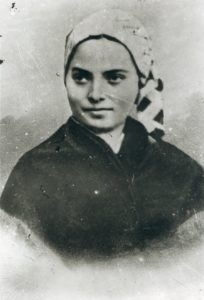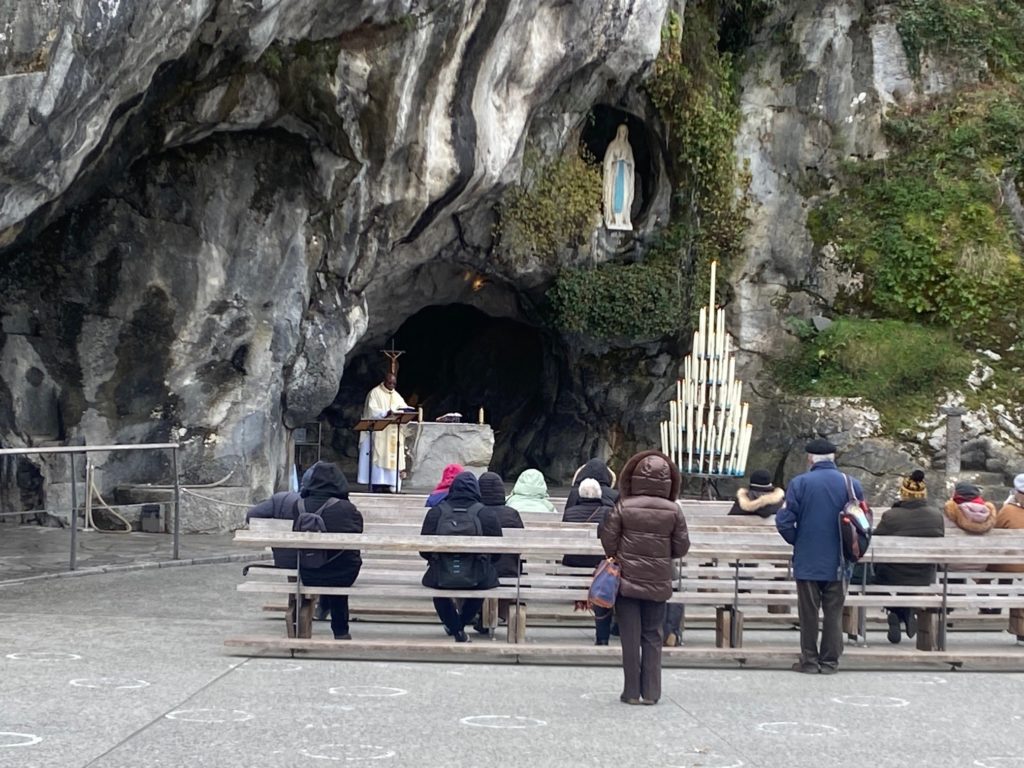I received a miraculous gift of sorts this winter: an unexpected invitation to visit Lourdes, France.
Lourdes is a bit like Italy’s Assisi: It can be crowded with pilgrims and tourists. It can be stacked floor to ceiling with Catholic kitsch. Despite that, it retains a spiritual power. Nestled near the Pyrenees not far from the Spanish border, the town has an undeniable beauty even in the chill of the French winter.
The Gave de Pau River slices rapidly through the pilgrimage site, carrying the snowmelt from the mountains towering nearby. Two basilicas, one on top of the other, loom over the grotto and the spring that attract all the attention. Yet the churches’ grandeur is almost diminished by the contrast with what is nestled below.
The stony grotto was basically the town dump. Yet it was here that a 14-year-old girl named Bernadette Soubirous encountered “the beautiful lady” in 1858. Following the lady’s instructions, Bernadette dug at the earth, uncovering the spring that runs to this day. The waters of that spring have led to claims of many healings, though scientific analysis shows nothing unusual about the water itself.
The story of Bernadette’s 18 well-documented encounters with “the lady” has been the subject of books, films and perhaps soon a musical. “The lady” eventually told her that her name was the Immaculate Conception, a phrase that the poorly educated Bernadette did not understand even as she dutifully recounted it to her pastor.

What is remarkable about the Bernadette story are the details: A young, uneducated, asthmatic girl who never changed her account despite numerous interrogations. Her faith was simple and unshakable. The Blessed Virgin did not promise her happiness in this life, she said, and Bernadette hid from her subsequent celebrity in a distant convent. She died of tuberculosis at age 35.
Yet the healings associated with the spring have continued ever since. After intensive investigation and documentation, 70 of these healings have been judged as having no known natural explanation. The 70th was recently discussed on the CBS news program “60 Minutes.” It concerned Sister Bernadette Moriau, who doctors testify was suddenly and without warning healed of a series of skeletal and neurological handicaps.
The fame of Bernadette’s visions and those healing waters have led to Lourdes today having the second largest concentration of hotels in France after Paris. A town of 17,000, it hosts 3 million pilgrims and tourists each year. The legacy of St. Bernadette remains evident in the parade of both believers and nonbelievers coming to the town, washing in and drinking the water as the Madonna instructed.
In Catholicism, contrary to some stereotypes, Church leaders are often skeptical about claims of miracles and apparitions. There is rarely any sort of rush to bless such claims. Church officials at first disbelieved Bernadette’s story even as a growing number of laity did not. The Church wisely notes that such claims can be sincere but imagined, and that many frauds can be perpetrated on the pious. Nothing is quicker to bring discredit on religious faith or joy to the breast of the cynic.
For those who disbelieve miracles are possible, there may never be convincing evidence. Disbelief as well as belief both ultimately turn on faith, but in the case of the Lourdes miracles, science has helped rule out other explanations.
Walking the granite plazas of Lourdes, I thought about all the miraculous healings we read of in the New Testament. They are closely connected with faith. Where faith was lacking, as in Nazareth (Matthew 13:58), miracles were few. On the other hand, where faith was strong — the hemorrhagic woman (Matthew 9:22), the Canaanite woman (Matthew 15:28), the two blind men (Matthew 9:29) — faith was rewarded.

Miracles can challenge even us believers, who share the prayer of the distraught father in the Gospel of Mark (9:24): “I do believe, help my unbelief!”
Miracles do not guarantee faith will last. One thinks of the 10 lepers cured but only one returns to give thanks (Luke 17:17–19). Yet faith makes miracles possible. These are the moments when the curtain is lifted, and we are allowed a glimpse of what lies beyond our mortal sight.
That such miracles should happen in a rubbish pit of sorts is no more or less improbable than the savior of the world born in a feedbox in a stable. Miracles, God seems to be telling us, can happen anywhere.
The shame of it is that we don’t recognize miracles happening all about us. Yet when my wife and I went to the grotto and washed and drank of the water that frigid January day, we shared a holy bond with all the millions of pilgrims who came before us and will follow us in faith and expectation that this is more than just water, more than just a spring.

